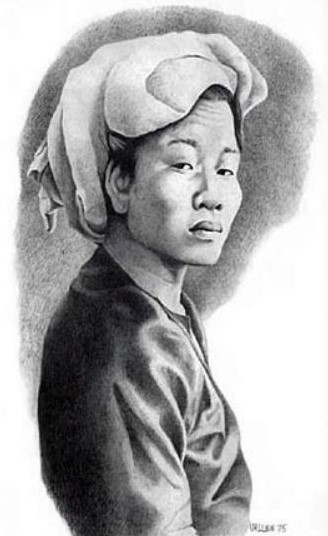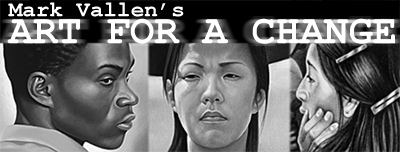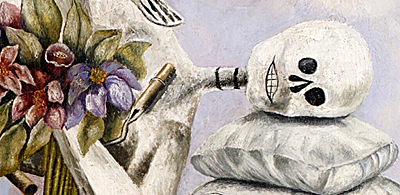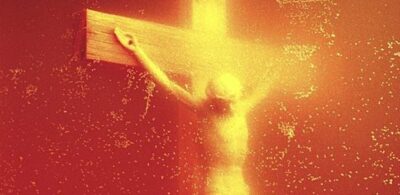Artists & The Vietnam War

April 30th, 2005, marks the 30th anniversary of the US defeat in Vietnam. As a twenty two year old in 1975, I commemorated the end of the war by creating a large oil painting simply titled, Vietnam. The preliminary sketch for that painting is reproduced at left.
The Vietnamese peasant woman portrayed in my artwork glances at you with cold regard, her stare is not celebratory but accusatory.
In observing the 30th anniversary of the end of what the Vietnamese called “The American War,” I have to mention that the conflict, and the world-wide opposition to it, were defining factors in my early artistic development.
A New York artist’s group called Artists & Writers Protest published an appeal in the New York Times titled, End Your Silence. Addressing the expanding US intervention in Vietnam, the statement opened, “We artists of the United States are divided in many ways, artistically and ideologically, but we are one in our concern for Humanity.”
That appeal made in 1965 galvanized my own feelings about the social role of artists, and it did the same for many others in the arts community. Meanwhile, in my home city of Los Angeles during the same year, a group called the Artists Protest Committee took to demonstrating against the Vietnam war in front of museums and galleries. They even picketed the Rand Corporation, “to protest Rand’s involvement with American foreign policy in Vietnam.”
In 1966 the Artists Protest Committee organized the Peace Tower, which stood at the corner of Sunset and La Cienega Boulevards. The sculpture, designed by artist Mark di Suvero and Mel Edwards, was covered with over 400 small panels submitted by artists from all around the world. Each panel was an artistic antiwar statement, and some of the artists who submitted works include Philip Evergood, Moses and Raphael Soyer, Robert Motherwell, Jim Rosenquist, Philip Pearlstein, Arnold Meshes, and Judy Chicago.
At the public dedication of the short lived monument against the war (dismantled after a few controversial months), there were speeches made by art critic and author, Susan Sontag, and Donald Duncan – an ex-Green Beret who said, “I am not here today to protest our boys in Vietnam – I’m here to protest our boys being in Vietnam.”
US artists once shook the national conscience and spurred debate and awareness about war through their works of art, and as a first year high school student in 1967, I was deeply influenced and inspired by what I saw my fellow artists doing. As the war dragged on and my commitment to a socially conscious art deepened, I found that hundreds of working professional artists across the country shared my concerns. Even abstract artists who had no direct messages in their works were moved to get involved with the antiwar movement.
A good example of this was the 1968 showing of minimalist art at the Paula Cooper Gallery in New York’s SoHo district. Of all the artists participating, not a single one presented artworks that had anything to do with the war, however the group wrote a collective statement that read, “These 14 non-objective artists are against the war in Vietnam. They are supporting this commitment in the strongest manner open to them by contributing major examples of their current work. The artists and the individual pieces were selected to present a particular aesthetic attitude, in the conviction that a cohesive group of important works makes the most forceful statement for peace.” The exhibition was organized as a benefit for the Student Mobilization Against the War, and the artists succeeded in raising $30,000 for the cause.
In May of 1970 the US expanded its unpopular war by bombing and invading Cambodia. The home front reaction was immediate, nearly every campus in the nation was shut down by demonstrating students. National Guard units sent to quell protests ended up massacring 4 students of Kent State. The nation was tearing itself apart.
Also in May, nearly 2,000 artists gathered at New York University to organize a day long Art Strike. It was agreed that May 22nd would be the target date for the strike. A statement explaining the action was drawn up and distributed to museums, galleries, and the press. On the actual day of the shutdown, the Jewish Museum, the Whitney Museum, and fifty private galleries shut their doors. The Museum of Modern Art (MoMA) stayed open but ran an antiwar film festival free of charge. Frank Stella closed his MoMA exhibit for the strike. The Guggenheim Museum remained open – but waved entry fees and removed all paintings from its walls. Meanwhile, the Metropolitan Museum of Art had been targeted for a major demonstration by artists for refusing to participate in the Art Strike. For nearly the entire day, hundreds of artists carrying signs reading “Art Strike Against Racism, War, Repression” leafleted those entering the museum.
Throughout the Vietnam war, artists contributed their works, skills and names to the antiwar movement. Pop artists Claes Oldenburg, Robert Rauschenberg, James Rosenquist, and Ed Kienholz made works that referenced the war. Alexander Calder designed a button for the New Mobilization Committee to End the War in Vietnam, a national mass protest held in Washington D.C. in 1969. Many African American artists like Cliff Joseph of New York’s Black Emergency Cultural Coalition railed against war. Even the normally apolitical Andy Warhol had created a series of silk-screens prints in 1972 for the antiwar Presidential candidacy of George McGovern, then running against Richard Nixon.
When I created my Vietnam painting at the close of the war 30 years ago, I could not have imagined that America would have so quickly forgotten the tragic lessons of that misbegotten imperial adventure. Yet memories of Vietnam still haunt Americans as the US conducts a brutal occupation of Iraq. Up to 100,000 Iraqi civilians have died in the war, with 1,573 American soldiers killed and an estimated 20,000 wounded as of this writing – causing some to call Iraq, “America’s new Vietnam.”
It is in this context that I make an appeal to all artists, and offer my commentary as a challenge. There’s a war going on. Leave behind the isolation of your studios and your focus on pure aesthetics, and instead become engaged in the world around you. Now is the time to confront the deadly realities that plague humanity, and art is the best means we have to envision and implement a new, just, and peaceful world.
[ To see full color examples of artworks created in opposition to the Vietnam war by Jasper Johns, Antonio Frasconi, Duane Hanson and others, visit: www.art-for-a-change.com/vietnam/vietnam.htm ]



